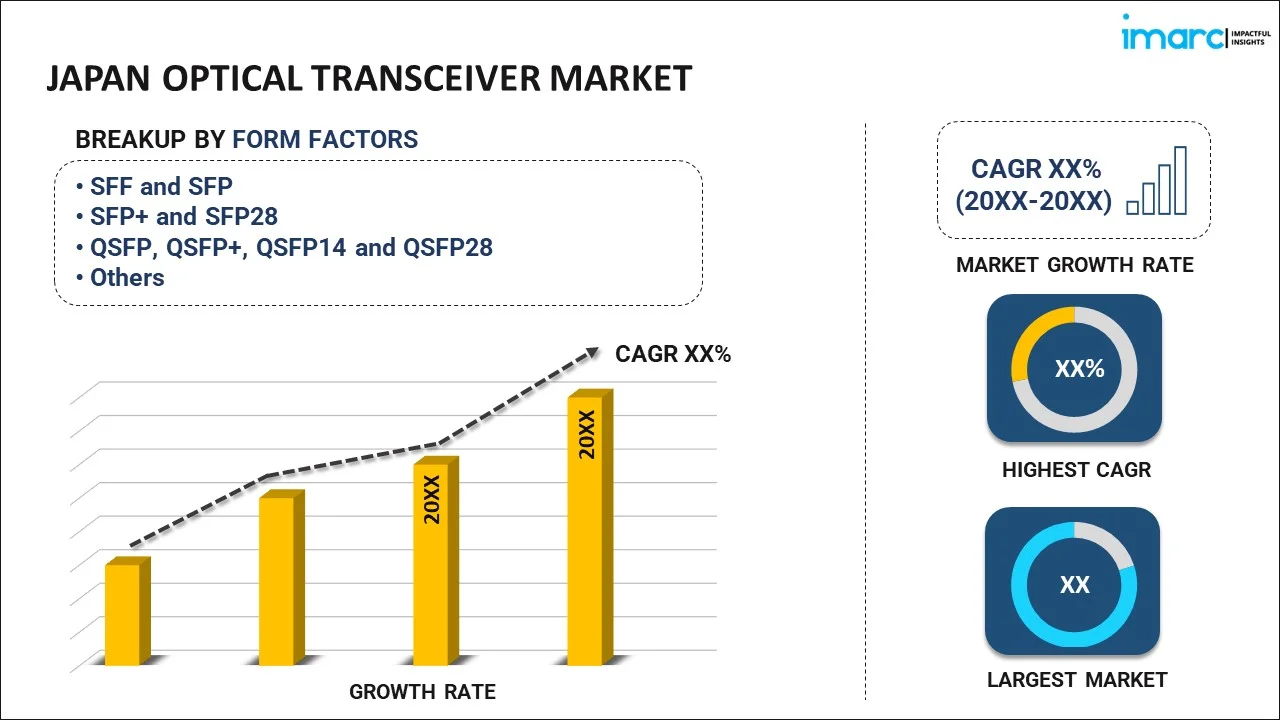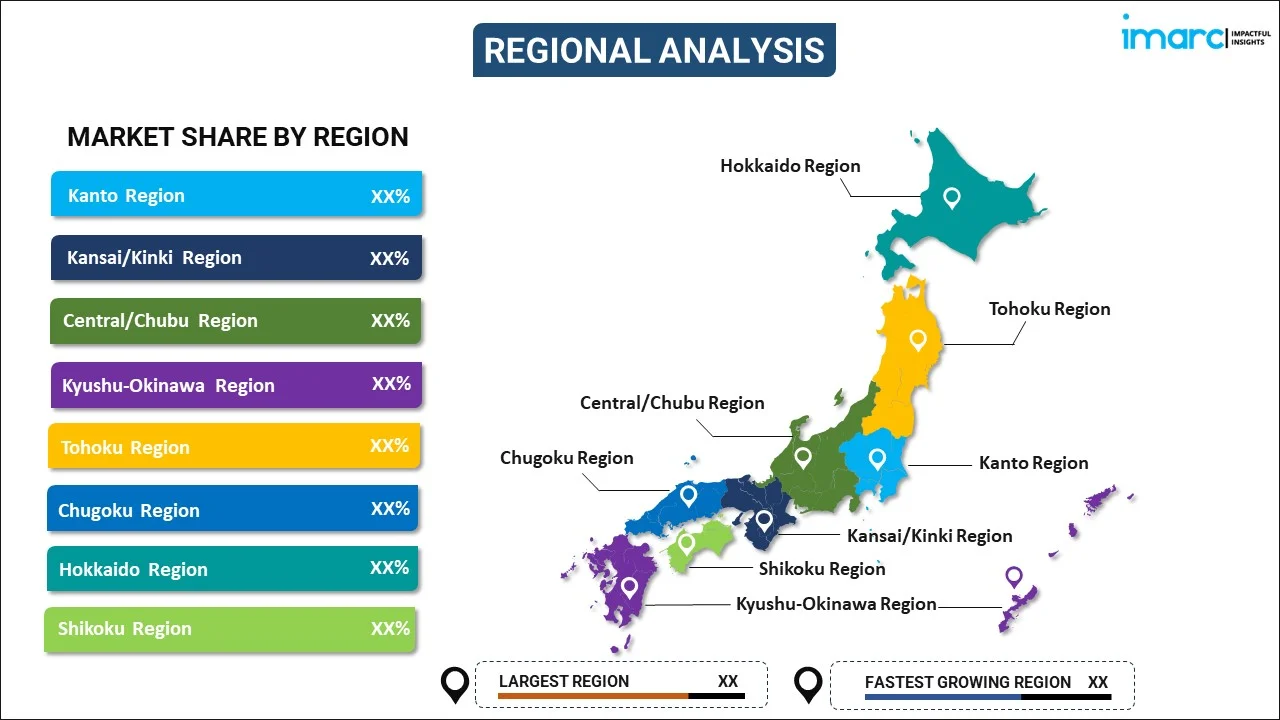
Japan Optical Transceiver Market Report by Form Factor (SFF and SFP, SFP+ and SFP28, QSFP, QSFP+, QSFP14 and QSFP28, CFP, CFP2, and CFP4, XFP, CXP, and Others), Fiber Type (Single Mode Fiber, Multimode Fiber), Data Rate (Less Than 10 Gbps, 10 Gbps To 40 Gbps, 40 Gbps To 100 Gbps, More Than 100 Gbps), Connector Type (LC Connector, SC Connector, MPO Connector, RJ-45), Applications (Data Center, Telecommunication, Enterprises), and Region 2025-2033
Market Overview:
Japan optical transceiver market size reached USD 745.4 Million in 2024. Looking forward, IMARC Group expects the market to reach USD 2,168.9 Million by 2033, exhibiting a growth rate (CAGR) of 11.97% during 2025-2033. The increasing demand for 5G networks, which requires advanced optical transceivers for high-speed, low-latency communication between base stations and core networks, is driving the market.
|
Report Attribute
|
Key Statistics
|
|---|---|
|
Base Year
|
2024 |
|
Forecast Years
|
2025-2033 |
|
Historical Years
|
2019-2024
|
| Market Size in 2024 | USD 745.4 Million |
| Market Forecast in 2033 | USD 2,168.9 Million |
| Market Growth Rate (2025-2033) | 11.97% |
An optical transceiver, often referred to as an optical transponder, is a crucial component in modern data communication systems. It serves as the bridge between electrical signals in network devices like routers and switches and optical signals transmitted over fiber optic cables. Optical transceivers are designed to convert incoming electrical data into optical signals for transmission and to receive incoming optical signals and convert them back into electrical data. These transceivers come in various form factors and support different data rates and optical transmission technologies, such as Ethernet, Fiber Channel, and SONET/SDH. They are used in a wide range of applications, from data centers and telecommunications networks to enterprise and industrial settings. Optical transceivers play a vital role in enabling high-speed, long-distance data transmission with minimal signal loss and electromagnetic interference. They contribute to the efficiency, reliability, and scalability of modern communication networks by facilitating the seamless integration of optical and electrical signals. As technology advances, optical transceivers continue to evolve, offering faster speeds and improved performance to meet the ever-increasing demands of the digital world.
Japan Optical Transceiver Market Trends:
The optical transceiver market in Japan is experiencing robust growth, primarily driven by several key factors. Firstly, the increasing demand for high-speed data transmission in various applications, including data centers, telecommunications, and enterprise networks, is a significant driving force. Moreover, the proliferation of cloud computing and the continuous expansion of 5G networks are compelling businesses to invest in optical transceivers to meet the escalating bandwidth requirements. Additionally, advancements in technology, such as the development of smaller form factors and higher data rates, are encouraging the adoption of optical transceivers. Furthermore, the rising awareness of energy efficiency and sustainability is pushing the market forward, as optical transceivers are known for their lower power consumption compared to traditional copper-based solutions. Furthermore, the escalating need for increased network security and reduced electromagnetic interference is contributing to the market's growth, as optical transceivers offer inherent security benefits and immunity to interference. Lastly, the regional shift toward remote working and the Internet of Things (IoT), which can sustain the demand for optical transceivers, making them indispensable components in modern communication networks, is expected to drive the market in Japan during the forecast period.
Japan Optical Transceiver Market Segmentation:
IMARC Group provides an analysis of the key trends in each segment of the market, along with forecasts at the country level for 2025-2033. Our report has categorized the market based on form factor, fiber type, data rate, connector type, and application.
Form Factor Insights:

- SFF and SFP
- SFP+ and SFP28
- QSFP, QSFP+, QSFP14 and QSFP28
- CFP, CFP2, and CFP4
- XFP
- CXP
- Others
The report has provided a detailed breakup and analysis of the market based on the Form factor. This includes SFF and SFP, SFP+ and SFP28, QSFP, QSFP+, QSFP14 and QSFP28, CFP, CFP2, and CFP4, XFP, CXP, and others.
Fiber Type Insights:
- Single Mode Fiber
- Multimode Fiber
A detailed breakup and analysis of the market based on the fiber type have also been provided in the report. This includes single mode fiber and multimode fiber.
Data Rate Insights:
- Less Than 10 Gbps
- 10 Gbps To 40 Gbps
- 40 Gbps To 100 Gbps
- More Than 100 Gbps
The report has provided a detailed breakup and analysis of the market based on the data rate. This includes less than 10 Gbps, 10 Gbps to 40 Gbps, 40 Gbps to 100 Gbps, and more than 100 gbps.
Connector Type Insights:
- LC Connector
- SC Connector
- MPO Connector
- RJ-45
A detailed breakup and analysis of the market based on the connector type have also been provided in the report. This includes LC connector, SC connector, MPO connector, and RJ-45.
Application Insights:
- Data Center
- Telecommunication
- Enterprises
The report has provided a detailed breakup and analysis of the market based on application. This includes data center, telecommunication, and enterprises.
Regional Insights:

- Kanto Region
- Kansai/Kinki Region
- Central/ Chubu Region
- Kyushu-Okinawa Region
- Tohoku Region
- Chugoku Region
- Hokkaido Region
- Shikoku Region
The report has also provided a comprehensive analysis of all the major regional markets, which include Kanto Region, Kansai/Kinki Region, Central/ Chubu Region, Kyushu-Okinawa Region, Tohoku Region, Chugoku Region, Hokkaido Region, and Shikoku Region.
Competitive Landscape:
The market research report has also provided a comprehensive analysis of the competitive landscape. Competitive analysis such as market structure, key player positioning, top winning strategies, competitive dashboard, and company evaluation quadrant has been covered in the report. Also, detailed profiles of all major companies have been provided.
Japan Optical Transceiver Market Report Coverage:
| Report Features | Details |
|---|---|
| Base Year of the Analysis | 2024 |
| Historical Period | 2019-2024 |
| Forecast Period | 2025-2033 |
| Units | Million USD |
| Scope of the Report | Exploration of Historical Trends and Market Outlook, Industry Catalysts and Challenges, Segment-Wise Historical and Future Market Assessment:
|
| Form Factors Covered | SFF and SFP, SFP+ and SFP28, QSFP, QSFP+, QSFP14 and QSFP28, CFP, CFP2, and CFP4, XFP, CXP, Others |
| Fiber Types Covered | Single Mode Fiber, Multimode Fiber |
| Data Rates Covered | Less Than 10 Gbps, 10 Gbps To 40 Gbps, 40 Gbps To 100 Gbps, More Than 100 Gbps |
| Connector Types Covered | LC Connector, SC Connector, MPO Connector, RJ-45 |
| Applications Covered | Data Center, Telecommunication, Enterprises |
| Regions Covered | Kanto Region, Kansai/Kinki Region, Central/ Chubu Region, Kyushu-Okinawa Region, Tohoku Region, Chugoku Region, Hokkaido Region, Shikoku Region |
| Customization Scope | 10% Free Customization |
| Post-Sale Analyst Support | 10-12 Weeks |
| Delivery Format | PDF and Excel through Email (We can also provide the editable version of the report in PPT/Word format on special request) |
Key Questions Answered in This Report:
- How has the Japan optical transceiver market performed so far and how will it perform in the coming years?
- What has been the impact of COVID-19 on the Japan optical transceiver market?
- What is the breakup of the Japan optical transceiver market on the basis of form factor?
- What is the breakup of the Japan optical transceiver market on the basis of fiber type?
- What is the breakup of the Japan optical transceiver market on the basis of data rate?
- What is the breakup of the Japan optical transceiver market on the basis of connector type?
- What is the breakup of the Japan optical transceiver market on the basis of application?
- What are the various stages in the value chain of the Japan optical transceiver market?
- What are the key driving factors and challenges in the Japan optical transceiver?
- What is the structure of the Japan optical transceiver market and who are the key players?
- What is the degree of competition in the Japan optical transceiver market?
Key Benefits for Stakeholders:
- IMARC’s industry report offers a comprehensive quantitative analysis of various market segments, historical and current market trends, market forecasts, and dynamics of the Japan optical transceiver market from 2019-2033.
- The research report provides the latest information on the market drivers, challenges, and opportunities in the Japan optical transceiver market.
- Porter's five forces analysis assist stakeholders in assessing the impact of new entrants, competitive rivalry, supplier power, buyer power, and the threat of substitution. It helps stakeholders to analyze the level of competition within the Japan optical transceiver industry and its attractiveness.
- Competitive landscape allows stakeholders to understand their competitive environment and provides an insight into the current positions of key players in the market.
Need more help?
- Speak to our experienced analysts for insights on the current market scenarios.
- Include additional segments and countries to customize the report as per your requirement.
- Gain an unparalleled competitive advantage in your domain by understanding how to utilize the report and positively impacting your operations and revenue.
- For further assistance, please connect with our analysts.
 Inquire Before Buying
Inquire Before Buying
 Speak to an Analyst
Speak to an Analyst
 Request Brochure
Request Brochure
 Request Customization
Request Customization




.webp)




.webp)












